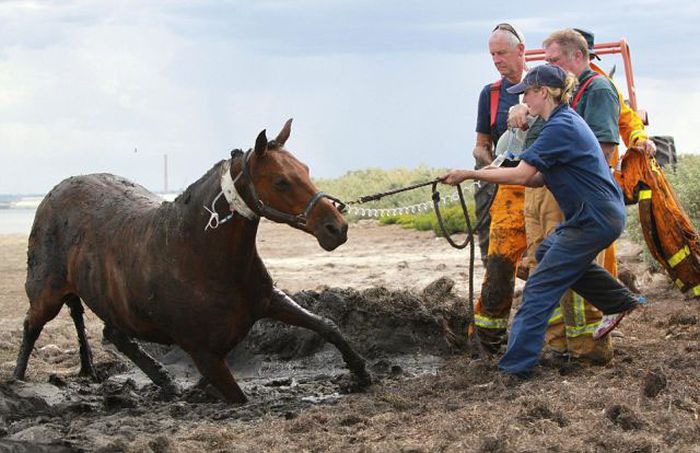|
|
Rescuing A Horse Stuck In Mud, Avalon Beach, Corio Bay, Victoria, Australia
|
All horses move naturally with four basic gaits: the four-beat walk, which averages 6.4 kilometres per hour (4.0 mph); the two-beat trot or jog at 13 to 19 kilometres per hour (8.1 to 12 mph) (faster for harness racing horses); the canter or lope, a three-beat gait that is 19 to 24 kilometres per hour (12 to 15 mph); and the gallop. The gallop averages 40 to 48 kilometres per hour (25 to 30 mph), but the world record for a horse galloping over a short, sprint distance is 88 kilometres per hour (55 mph). Besides these basic gaits, some horses perform a two-beat pace, instead of the trot. There also are several four-beat "ambling" gaits that are approximately the speed of a trot or pace, though smoother to ride. These include the lateral rack, running walk, and tölt as well as the diagonal fox trot. Ambling gaits are often genetic in some breeds, known collectively as gaited horses. Often, gaited horses replace the trot with one of the ambling gaits.
Behavior
Horses are prey animals with a strong fight-or-flight response. Their first reaction to threat is to startle and usually flee, although they will stand their ground and defend themselves when flight is not possible or if their young are threatened. They also tend to be curious; when startled, they will often hesitate an instant to ascertain the cause of their fright, and may not always flee from something that they perceive as non-threatening. Most light horse riding breeds were developed for speed, agility, alertness and endurance; natural qualities that extend from their wild ancestors. However, through selective breeding, some breeds of horses are quite docile, particularly certain draft horses. Horses are herd animals, with a clear hierarchy of rank, led by a dominant individual, usually a mare. They are also social creatures who are able to form companionship attachments to their own species and to other animals, including humans. They communicate in various ways, including vocalizations such as nickering or whinnying, mutual grooming, and body language. Many horses will become difficult to manage if they are isolated, but with training, horses can learn to accept a human as a companion, and thus be comfortable away from other horses. However, when confined with insufficient companionship, exercise, or stimulation, individuals may develop stable vices, an assortment of bad habits, mostly stereotypies of psychological origin, that include wood chewing, wall kicking, "weaving" (rocking back and forth), and other problems.
|
|









